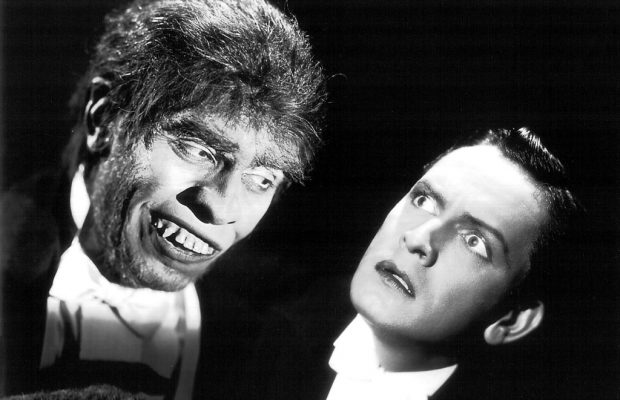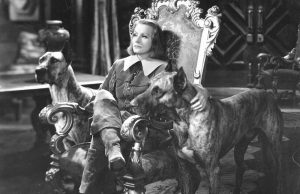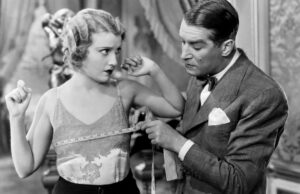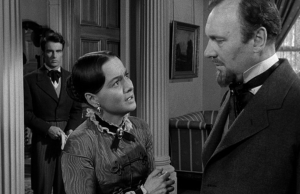Dr. Jekyll and Mr. Hyde (1931)
By Toronto Film Society on May 31, 2016
Toronto Film Society presented Dr. Jekyll and Mr. Hyde (1931) on Monday, December 3, 1979 in a double bill with The Searchers as part of the Season 32 Monday Evening Film Buff Series, Programme 4.
Production Company: Paramount. Producer and Director: Rouben Mamoulian. Script: Samuel Hoffenstein, Percy Heath. Based on the novel by Robert Louis Stevenson. Photography: Karl Struss. Art Direction: Hans Dreier.
Cast: Fredric March (Dr Henry Jekyll/Mr Hyde), Miriam Hopkings (Ivy Pearson), Rose Hobart (Muriel Carew), Holmes Herbert (Dr Lanyon), Edgar Norton (Poole), Halliwell Hobbes (Brig.-Gen. Carew), Arnold Lucy (Utterson), Tempe Pigott (Mrs Hawkins), Colonel McDonnell (Hobson).
In an unexpected departure from his normal impressionistic practice, Mamoulian begins Dr. Jekyll and Mr. Hyde with the celebrated sequence seen from Jekyll’s point of view, opening with a shot of organ pipes as a Bach fugue peals out, panning down to a close-up of hands on the keyboard, and remaining stubbornly subjective–sheet music on the organ, butler entering to remind him of his lecture, his reflection in the hall mirror as he puts on his hat and cloak, climbing into a carriage, arriving at the university–until he enters the lecture room, when the camera pans around in a 360° arc and, on the first word of his lecture, “Gentlemen…” cuts to the back of the auditorium for the first objective view of Jekyll himself. Arthur Knight notes that “the subjective camera built a growing suspense, a curiosity about the appearance of the man we know will turn into the monstrous Hyde”. Mamoulian himself has said that he wanted to draw the audience into Jekyll’s brain, to create an experience in which–as with the transformations–the audience does not see him–they are him”.
In any adaptation of Stevenson’s story, the transformation scene is inescapable: the audience is sitting waiting for the moment when handsome Jekyll will be metamorphosed into the deformed and diabolical Hyde, and Mamoulian plays the game beautifully. To this day he has refused to reveal the secret of how the transformations were achieved in front of the camera, but it is not difficult to guess that they were done with coloured filters, changed to reveal different layers of make-up, and given a hallucinatory sense of actually happening before our eyes by the extraordinary soundtrack. As described by Mamoulian: ‘To accompany the transformations I wanted a completely unrealistic sound. First I tried rhythmic beats, like a heart-beat. We tried every sort of drum, but they all sounded like drums. Then I recorded my own heart beating, and it was perfect, marvellous. Then we recorded a gong, took off the actual impact noise, and reversed the reverberations. Finally we painted on the soundtrack; and I think that was the first time anyone had used synthetic sound like that, working from light to sound.”…
Structurally, thematically and psychologically, Dr Jekyll and Mr Hyde is masterly, and superbly executed in Karl Struss’s velvety, glowing camerawork.
Mamoulian by Tom Milne, Thames & Hudson, 1969
You may also like...
-
News

Frances Blau
Toronto Film Society | February 27, 2024On Monday, February 26th, 2024, Toronto Film Society lost longtime friend, supporter, and board member Frances Blau. Known for her sense of humour, her love of film, her generosity,...
-
Special Events

The Ladykillers (1955) at the Paradise Theatre
Toronto Film Society | March 9, 2024Toronto Film Society presents Targets (1968) at the Paradise Theatre on Sunday, April 7, 2024 at 2:30 p.m. Ealing Studios arguably reached its peak with this wonderfully hilarious and...
Programming

Virtual Saturday Night at the Movies
Toronto Film Society | April 11, 2024Toronto Film Society is back in the theatre! However, we’re still pleased to continue to bring you films straight to your home! Beginning Season 73 until now we have...
4-
 Toronto Film Society | March 9, 2024
Toronto Film Society | March 9, 2024
-
 Toronto Film Society | November 6, 2022
Toronto Film Society | November 6, 2022
-
 Toronto Film Society | August 1, 2023
Toronto Film Society | August 1, 2023
Donate to Toronto Film Society – We’re now a Registered Charity!
-
Copyright © 2017 Toronto Film Society.







Leave a Reply